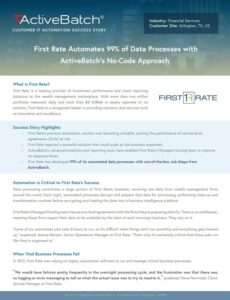How No-Code Automation Helps Simplify IT Processes [Case Study]
In a recent case study, First Rate’s IT team explains how no-code workload automation is used, why it is important, and what no-code means for the IT team.

No-Code Workload Automation Capabilities
In order to scale and grow as a business, IT teams need to automate processes throughout the organization. That requires two things:
- Streamlined integration capabilities, and
- Tools that simplify tasks for developers and operators.
Back in 2012, First Rate, a wealth management services company, began automating and managing its processes by leveraging a range of capabilities from ActiveBatch, a workload automation solution and job scheduler.
The features and capabilities leveraged by First Rate included:
- Prebuilt jobs
- Workflow designer
- Instances View
- Template Jobs
- Event triggers
- Constraints
- Revision histories
- And more…
In a recent case study, First Rate’s IT team explains how these workload automation capabilities are used, why they are important, and what they mean for their IT team.
Integrated Jobs Library:
ActiveBatch’s Integrated Jobs Library provides a catalog of prebuilt job steps that First Rate uses to assemble cross-platform workflows. Because these out-of-the-box job steps are prebuilt, First Rate is able to develop and automate data processes without having to write new scripts.
The Integrated Jobs Library includes tasks for popular solutions from Microsoft, Amazon, Oracle, and more, allowing First Rate to develop end-to-end workflows across its various platforms and technologies.
“ActiveBatch even has an SSIS Jobs Library job, so we’ve been able to run those packages through that tool as part of our workflow. SSIS has to be part of our workflows so I’m not sure how we would’ve gotten around that without ActiveBatch.”
“For building a job we’re just using the Jobs Library. We only run from the ActiveBatch scheduler, through the GUI —99% [of our jobs] are the Job Steps from the library.”
Template Jobs:
It’s not uncommon for First Rate’s developers to execute similar jobs for different workflows. To save themselves time, they create Template Jobs inside ActiveBatch, and then create hundreds or thousands of jobs that copy the same logic of the Template Job. A single change to the Template Job can then be passed directly to all jobs that reference it —meaning, instead of making changes to hundreds of individual jobs, the IT team only has to make the change once.
This allows for faster workflow development and streamlined maintenance.
“You can imagine, if I can’t copy a job and I have to recreate it from scratch, that’s just more technician time spent when they could be doing something else.”
“With ActiveBatch, when you copy a job it becomes its own object. So, you copy a job, go in and change a few things, and you’re done.”
“If it’s digital, ActiveBatch can do it.”
Find out how First Rate automated 99% of data processes with ActiveBatch’s No-Code Approach.
Event Triggers:
Event-based automation allows First Rate to automatically trigger jobs based on emails, file events, the completion status of preceding jobs, and just about anything else that can happen within an IT environment.
Before implementing ActiveBatch, First Rate had lacked the ability to trigger jobs based on external conditions. Instead, the IT team had to run additional jobs to monitor completion statuses, just so they could know when to manually run a workflow that was waiting for a dependency.
“Our jobs became very cumbersome because of that. They were very hard to manage and read. In ActiveBatch, it’s all contained within the job; you just go add the constraint. You have a lot of Boolean-types things you can do; it’s really pretty impressive.”
Using event triggers, First Rate’s IT team has streamlined and simplified processes, removing manual interventions and reducing errors.
Constraints:
First Rate has clients in different time zones around the world. With constraint-based scheduling options, First Rate customizes its jobs to meet specific client needs.
“The constraints features in ActiveBatch are pretty incredible; there’s a lot of flexibility there. The scheduling in ActiveBatch is very flexible, too —very granular. The ability to add holiday calendars was something we did not have in our previous automation solution. That’s definitely another thing that has allowed us to customize these jobs to the specific client needs.”
Revision History:
Revision History allows users to roll back changes with just one click. Users can easily compare changes made to objects and can then rollback to an earlier version. This saves developers time because they no longer have to manually undo changes —which also prevents mistakes from happening.
“That tool is amazing. If you make a change that doesn’t work and you need to go back, you just click on the previous one and click restore and you’re good to go.”
Instances View:
A job might run twice a day, or it might run 200 times a day. Either way, First Rate needs access to detailed records of each individual job run, especially for those jobs that run overnight.
The ActiveBatch Instances View provides a comprehensive list of all instances for a defined period and is often the first view that operators check on a day-to-day basis. The Instances View is powerful because it puts all instance information into a single window, with direct access to log files for each instance, should an operator need more details.
Because First Rate is able to manage its automated processes from a single, central location, First Rate is able to monitor its automated processes from a single, central location. That means faster workflow development and streamlined maintenance.
“In the morning, that’s the first thing we look at: what has actually had an issue overnight? The Instances View gives us a really quick view of what we need to focus on. And then obviously there’s all kinds of information you can dig into in ActiveBatch to find out even more.”
What is ActiveBatch Workload Automation?
ActiveBatch is a low-code IT automation solution that enables IT to orchestrate its automation environments. With hundreds of prebuilt job steps and integrations, ActiveBatch is designed to support virtually every digital tool or tech currently available, meaning IT can build seamless, end-to-end workflows across the organization —and that those workflows can be monitored and managed from a single window.
Ready for digital transformation? Find out how ActiveBatch IT Automation can help drive your organization’s transformation goals.
“If it’s digital, ActiveBatch can do it.”
Find out how First Rate automated 99% of data processes with ActiveBatch’s No-Code Approach.









